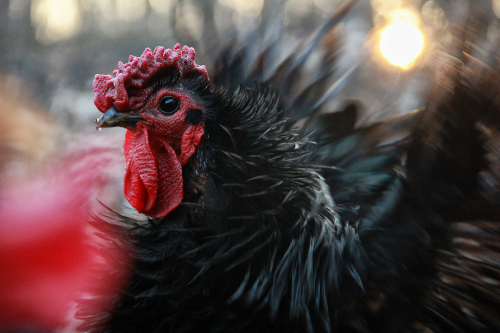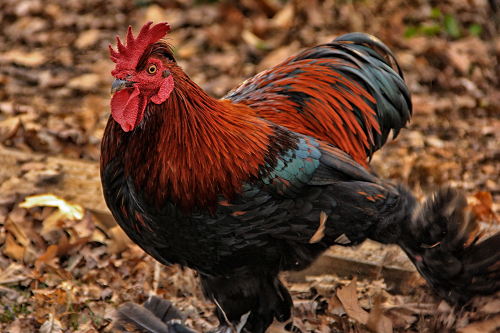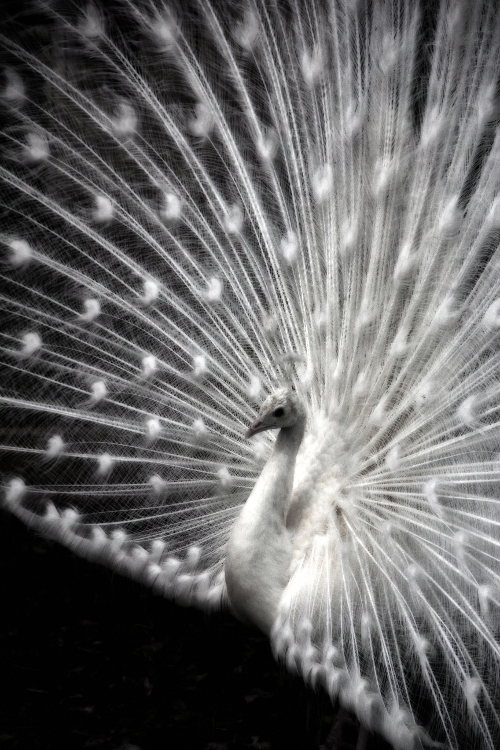Coop Lightening Part 1: A Birds Eye View and Part 2: Shedding Some Light
I am a blogger for Backyard Poultry Magazine. Part 1 of this article was originally posted on February 5, 2014 and Part 2 on February 10, 2014
Coop Lighting Part 1: A Birds Eye View
 Whether you are in my position, having just built a brand new state-of-the-art chicken coop and needing to find the right lighting, or you want to change or supplement the lighting in your existing structure, there are some very important things to consider before taking the plunge. Of course, our primary concern is what is best for the birds in our care. What is the best type of light and how much of it do they need? But for almost all of us, the secondary concern is how to get the most bang for our buck. We want the best value in both purchasing and running the lighting. It is a balancing act. One that I believe deserves some attention.
Whether you are in my position, having just built a brand new state-of-the-art chicken coop and needing to find the right lighting, or you want to change or supplement the lighting in your existing structure, there are some very important things to consider before taking the plunge. Of course, our primary concern is what is best for the birds in our care. What is the best type of light and how much of it do they need? But for almost all of us, the secondary concern is how to get the most bang for our buck. We want the best value in both purchasing and running the lighting. It is a balancing act. One that I believe deserves some attention.
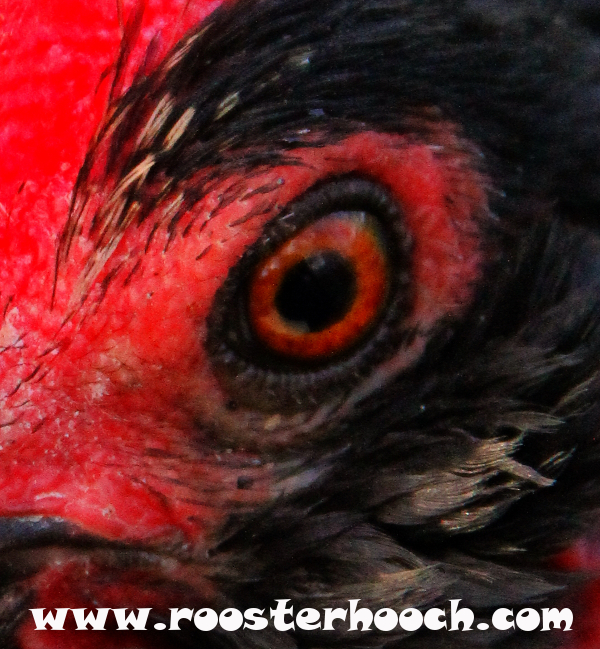 So let’s first take a look at the science behind chicken vision. Chickens need light for 2 major things: for seeing (obviously) and for regulating internal cycles, such a hormone release. Light for chickens, just as humans, affects a wide array of metabolic processes in the body. However, in our feathered friends we are primarily concerned with 3 main mechanisms that light affects, feed consumption and conversion, body weight and weight gain, and their reproductive cycles. By reproductive cycles, I’m not implying we should install mood lighting so Rocky Rooster has the optimal romantic lighting to woo Miss Henny. No, we care about reproduction in terms of the eggs that Miss Henny produces, not whether they are fertile. Regulating light properly keeps egg production on track.
So let’s first take a look at the science behind chicken vision. Chickens need light for 2 major things: for seeing (obviously) and for regulating internal cycles, such a hormone release. Light for chickens, just as humans, affects a wide array of metabolic processes in the body. However, in our feathered friends we are primarily concerned with 3 main mechanisms that light affects, feed consumption and conversion, body weight and weight gain, and their reproductive cycles. By reproductive cycles, I’m not implying we should install mood lighting so Rocky Rooster has the optimal romantic lighting to woo Miss Henny. No, we care about reproduction in terms of the eggs that Miss Henny produces, not whether they are fertile. Regulating light properly keeps egg production on track.
There is a little hurdle in configuring new coop lighting. Birds do not see in the same visual spectrum that we do. This means that, the parts of the electromagnetic spectrum that are visible to the human eye are different from the ones that chickens can see. Human eyes have what is called tri-chromatic vision, meaning they are most sensitive to the red, green and blue wavelengths of light. Chickens, on the other hand, have tetra-chromatic vision, meaning they are also sensitive to a fourth spectrum component called ultraviolet. This means that EVERYTHING they see looks different to them than it does us. So why does this cause a problem in configuring lighting? Well 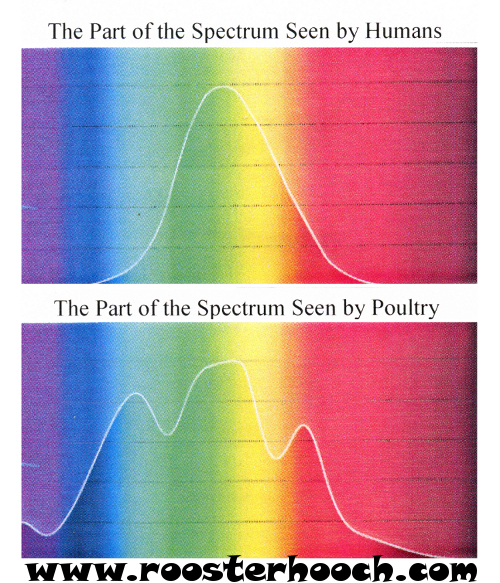 lighting sources are generally measured in Lumens. A Lumen is the total amount of VISIBLE light emitted from a source. But if the amount of light that is visible to our eyes is different from the amount that is visible to chickens, then how can we accurately measure the amount of light we are providing them? Researchers are now expressing these measurements in terms of c-lumen, which has been adjusted to the visual spectral response of domestic poultry. The problem is that when you drop by the home improvement store to pick out a light bulb, the manufacturer doesn’t provide chicken specifications on the packaging. So if we have a basic understanding of each type of lighting and the visual spectrum it produces, we are on the road to making the best choice. Two light sources can look identical to us, but can affect our poultry differently.
lighting sources are generally measured in Lumens. A Lumen is the total amount of VISIBLE light emitted from a source. But if the amount of light that is visible to our eyes is different from the amount that is visible to chickens, then how can we accurately measure the amount of light we are providing them? Researchers are now expressing these measurements in terms of c-lumen, which has been adjusted to the visual spectral response of domestic poultry. The problem is that when you drop by the home improvement store to pick out a light bulb, the manufacturer doesn’t provide chicken specifications on the packaging. So if we have a basic understanding of each type of lighting and the visual spectrum it produces, we are on the road to making the best choice. Two light sources can look identical to us, but can affect our poultry differently.
Coop Lighting: Part 2 Shedding Some Light
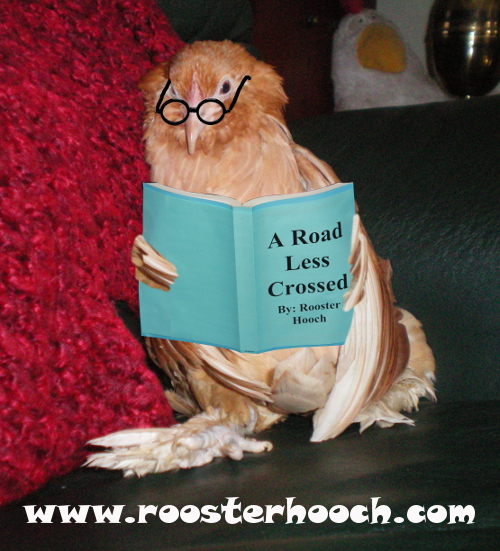 In Part 1, we discussed how chickens and humans see things differently and that they need light for both seeing and regulating internal cycles. Now, lets take a look at the three most common types of lights used in noncommercial poultry setups. They are Incandescent, Compact Fluorescents (CFL) and LED (Light emitting Diode).
In Part 1, we discussed how chickens and humans see things differently and that they need light for both seeing and regulating internal cycles. Now, lets take a look at the three most common types of lights used in noncommercial poultry setups. They are Incandescent, Compact Fluorescents (CFL) and LED (Light emitting Diode).
 Incandescent lights provide energy over the entire visual spectrum although more of the wavelengths are on the red side of the spectrum, which is what makes an incandescent light bulb appear a warmer color. A drawback is that they only produce 8-24 lumens per watt because much of the energy is wasted because it is converted to heat. It is the least efficient and therefore least economical of the three. As a quick reminder, steer clear of the bulbs that are called shatterproof or safety coated. They are coated with Teflon, which is highly toxic and usually fatal to confined birds.
Incandescent lights provide energy over the entire visual spectrum although more of the wavelengths are on the red side of the spectrum, which is what makes an incandescent light bulb appear a warmer color. A drawback is that they only produce 8-24 lumens per watt because much of the energy is wasted because it is converted to heat. It is the least efficient and therefore least economical of the three. As a quick reminder, steer clear of the bulbs that are called shatterproof or safety coated. They are coated with Teflon, which is highly toxic and usually fatal to confined birds.
 CFLs produce 60-69 lumens per watt and have a lifetime as much as 8 times greater than an incandescent bulb. However, the output will decrease over their lifetime around 20-30 percent. The wavelengths peak at certain colors on the spectrum, but the output over the entire spectrum tends to be rather low although relatively consistent. An unfortunate side effect of traditional fluorescent tube lights is that the light pulses. Think of a fluorescent tube that is dying, you can see it flicker, but birds potentially see that all the time and it can be very annoying to them. Most CFLs are designed not to do that though, making them a better choice that traditional fluorescent tubes.
CFLs produce 60-69 lumens per watt and have a lifetime as much as 8 times greater than an incandescent bulb. However, the output will decrease over their lifetime around 20-30 percent. The wavelengths peak at certain colors on the spectrum, but the output over the entire spectrum tends to be rather low although relatively consistent. An unfortunate side effect of traditional fluorescent tube lights is that the light pulses. Think of a fluorescent tube that is dying, you can see it flicker, but birds potentially see that all the time and it can be very annoying to them. Most CFLs are designed not to do that though, making them a better choice that traditional fluorescent tubes.
 LED lights give monochromatic light from different wave lengths, i.e., white, green, red. They have high energy efficiency, a long life and high reliability with low maintenance and operation costs. Although in most cases the initial cost is higher than either of the other lighting sources.
LED lights give monochromatic light from different wave lengths, i.e., white, green, red. They have high energy efficiency, a long life and high reliability with low maintenance and operation costs. Although in most cases the initial cost is higher than either of the other lighting sources.
There have been numerous studies done on the effects of each of the lighting sources on chickens. Without going into boring scientific detail, birds generally performed better under CFL than incandescent. Still better, studies done with broilers concluded that over all LED lighting showed better results in all of the areas of primary concern, meaning growth and reproduction, than CFL. Another study got so specific that it found the birds reacted differently to specific colors of LED light. The results showed that green light stimulated more exploration, presumably from the fact that from an evolutionary stand point, sensitivity to green light is what allowed them better ability to forage under forest canopies. The red light accelerated sexual development and made them less aggressive. But before you go setting up a red light district in your chicken coop, plain white light emitting LEDs showed the best overall results.
So the final consideration for lighting is that although in winter the colder temperatures can reduce egg production, darkness is the main reason production begins to slow in late fall. Research shows that chickens are most productive when they receive about 15 hours of light daily. In the northern United States, natural daylight drops to less than 9 hours per day at the end of December. So the type of lighting is important, but the amount of time you provide supplemental light to your flock is also vital. I personally go out to my chicken barn morning and evening to turn the light on and off. It gives me an opportunity to check in with everybirdie and make sure there are no issues. Not everyone has that luxury, so a timer for your lighting  could be your best friend.
could be your best friend.
I encourage everyone to take the information I have provided and make the decision that best fits your circumstances. I personally chose LED lighting. I just installed inexpensive strip lighting to replace the temporary fluorescent tube lighting. In just 2 weeks time I went from receiving one or two eggs a day from my girls to a dozen or more. My girls are happy and so am I. So I can personally attest to the efficacy of LED lighting, but the choice is yours.
